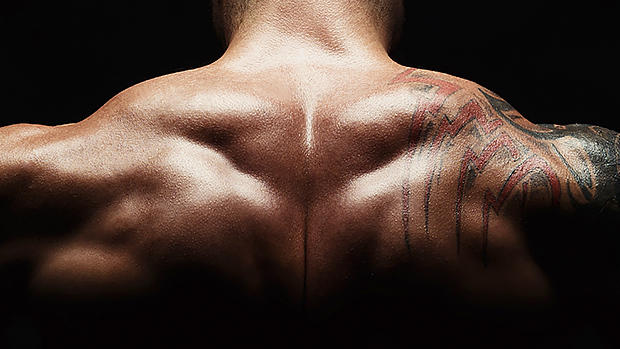Here's what you need to know...
- Optimize the function of your thoracic spine and your elbows will get less worn out from pressing and your stiff neck will relax.
- If your spine is working properly, any overhead movements you do will quickly improve.
- Do this test after completion of each training program and you might just be able to fire your physical therapist and your chiropractor!
I hate pain. I hate when it messes up my workouts, my emotional state, and my life in general. I know you feel the same way. My goal, my personal mission, is to give you a system to quickly identify the real issues and quickly fix them so you can, in some ways, be your own physical therapist.
We Need a Standard
Physical therapists, chiropractors, orthopedic surgeons, etc., have always known what appropriate joint movement is. Unfortunately, you and I don't learn these appropriate joint movements until we get hurt and have to make an appointment to see one of them! –I think that's a horrible model. Instead, we need to know these things up front so we can fix minor issues before they become major ones.
Gray Cook has a great tool for looking at movement called The Functional Movement Screen, or FMS for short. I've used it for 10 years with good results. The only down side is you need to go see someone like myself to get screened, and I'm not cheap.
But I want to give you something you can do quickly and without confusion. What's needed is to peel back movement to single joint function rather than movement patterns. That way, there are fewer movement patterns involved. Now all we need to do is determine whether or not you can do the basic single-joint movement. It needs to be that simple and that easy.
I 'm going to concentrate on one area – the thoracic spine (T-spine) – and I'll explain how to self-screen and self-correct. You can then use this as a baseline movement guide forever and maybe even tell your orthopedist to kiss off.
Why You Should Care about the T-Spine
You shouldn't waste your time on anything that doesn't yield results in life. Training is no different. When you free up your T-spine so that it moves properly again, you'll see a chain reaction of things start to happen. Your shoulders will move easier. Your elbows will get less worn out from bench pressing, and your stiff neck will start to relax. Your posture will be less geek-like. On the performance front, anything you do overhead will greatly improve. Chin-ups, pull-ups and overhead pressing of any kind will skyrocket.

What is the T-spine?
I'll make this short. The thoracic spine begins at the base of the neck with T1, attaches to C7 (base of the neck), and continues down to T12, where it attaches to L1 (beginning of the lower back). You can see that this is the bridge between the neck and the lower back, the two most injured areas in the human body. The ribs are also attached from T1 all the way down to T12, which indicates how important the T-spine is because the ribs act as a protective layer around the organs.
Just a Tiny Bit of Anatomy and Phys
The T-spine is the bridge between your lumbo-pelvic complex and your shoulder-neck complex. If you bench press, do pull-ups, perform curls, or do anything with your arms, you're using your T-spine as a stable anchor to move your arms. Evan Osar, in his book Corrective Exercises to Common Hip and Shoulder Dysfunction, points out that the T-spine needs to be able to act as a stable anchor on one side, while moving on the other.
When the T-spine is locked into place and can't move through its normal range of movement, the scapula can't slide, glide, or stay stable. In lifting terms that means poor position, weak lifts, and stiff shoulders. If you can't stabilize correctly with the scapula you have to find stability somewhere else. In pain terms, this means the neck stiffens up as a secondary stabilizer.
An Easy Way to Assess the T-Spine
The T-spine has largely been ignored in the past. In one of the best books on bony landmarks and joint ranges of motion, Physical Examination of the Spine and Extremities (1976) by Stanley Hoppenfeld, the thoracic spine isn't even included, and perversely the book is a classic referral for doctors!
Thankfully, it's becoming increasingly common to evaluate the T-spine and there's been some solid work in the field, notably by physical therapist Shirley Sahrmann and Gray Cook. The assessment I'm going to show you is based on their work.
Keep in mind that all ranges of motion are important: flexion, extension, and rotation, but lack of T-spine extension and rotation are the most common issues. Luckily for us, rotation also exposes extension issues. This allows us to use rotation as the primary screen. See if you can pass the test below:
If you can easily pass the assessment, great, your T-spine most likely isn't an issue. Just re-check it every couple of months after you complete a program to make sure it hasn't stiffened up. If it is an issue for you, follow the corrective exercises below.
Notes
- On Correction – 1, spend the most time on the area or areas that are particularly stiff as you extend back down to the ground.
- On Correction – 2, lean back as demonstrated to access some extra stiffness that rarely gets addressed in stretching or basic foam rolling.
- On Correction – 3, work your way from the lower ribs to the upper ribs, exhaling on the rotation.
- Spend 5 to 10 minutes working on these before upper body lifting and once again at night for two straight weeks and you should be in circus gymnast shape, function-wise.




